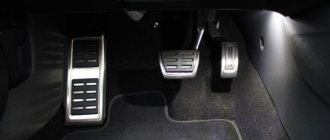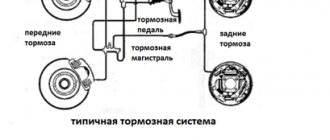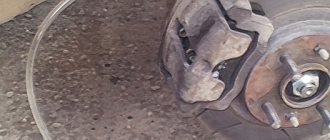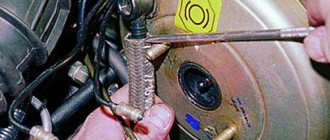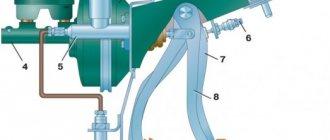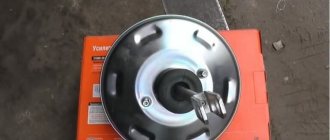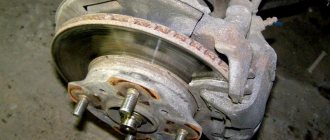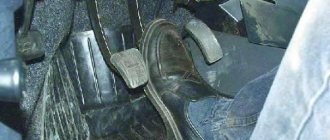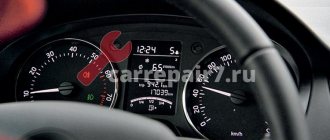A serviceable and efficient braking system of a car is a guarantee not only of road safety, but also often the safety of the life of the driver, passengers and pedestrians. And one of the signs of serious problems for the car and its owner is a situation when the brake pedal fails. This process can occur either slowly or quickly. It happens that a recessed pedal does not return to its place at all. In any case, all of the above signs are a reason for serious diagnostics of the brake system. However, first you should find out what caused the emergency situation.
Why does the brake pedal fail?
One of the elements of the described hydraulic system is a special composition circulating through tubes and other cavities. The main feature of brake fluid is that it cannot be compressed. As a result, the force from pressing the pedal is transferred “unchanged” to the pads, which stop the rotation of the wheel. “Sinking” indicates that the line has become larger in volume or has depressurized. The main causes of the problem are discussed below.
Low quality brake fluid
The composition circulating in the system is quite aggressive. Gradually, bad brake fluid begins to corrode rubber and even metal parts, hoses, and tubes through which it moves. The walls of the latter become thinner to such an extent that they swell when pressure is created. Because of this:
- an excess volume is created into which the brake fluid goes;
- when you add it, the pressure is restored, but the tubes may not be able to withstand it: microcracks form through which the liquid gradually leaves and air enters instead (when the pedal moves in the opposite direction, it is literally sucked in). In the worst situation, the hoses may burst.
Air in the brake system
Its entry into the line is a consequence of depressurization of components and parts of the brake system. A plug may also form due to the fact that the fluid level in the tank has dropped below the existing MIN mark. Another reason is improper bleeding of the brakes when replacing the circulating compound. The danger with air in the system is that, unlike liquid, it is compressed. As a result, the force applied to the pedal goes to waste - in the literal sense of the word.
Master cylinder malfunction
Its main problem is most often related to depressurization. This occurs due to deformation and rupture of seals - cuffs. Their destruction is caused by poor-quality brake fluid or natural aging of the elements. The main brake cylinder becomes leaky even if scratches or wear appear on its walls.
This occurs due to the appearance of foreign particles in the line. They can get inside if the system is carelessly and inaccurately filled. Sometimes “extra” elements are wear and tear products if the car has been in use for a long time.
Repairing a brake cylinder is a difficult task. If you do not have the relevant experience and do not have special tools or devices, it is better to take the part to a workshop or buy a new one.
Problems with the vacuum booster
If it is faulty, then most often this can be determined by the characteristic hissing sound that occurs when you press the brake pedal. This situation may indicate depressurization of the vacuum pump. The reason may lie in a ruptured diaphragm, seals, or a broken equalizing valve. To solve the problem, purchase a repair kit and replace all rubber parts. Air can also enter the vacuum booster due to cracks in the underwater pipes: tighten the clamps on them or, if damaged, replace them (in a carburetor car, such a hose fits at the bottom of it).
Incorrect clearances
We are talking about the presence of a gap between the main brake cylinder (its rod) and the pedal. The latter in this case fails and remains in this position. If the clearance is correct, the pedal will initially move smoothly, but at a certain period of travel it will become stiff. If the distance to the GTZ rod is large, resistance to pressing will be felt only at the very end of the stroke.
Unprofessional repair
The reason when the brake pedal fails may lie in the caliper, the fastenings of which are not tightened well enough. Then its vertical axis will be shifted in relation to the brake disc and the pads will not be able to get used to function properly. Also, any unprofessional actions (poor tightening, lack of spring washers where needed, etc.) when repairing or bleeding the brake system will lead to its ineffective operation.
Corrosion
The metal that makes up some of the brake system elements can simply rust. In such cases, the pedal goes down and freezes there, from where it has to be “picked out” with a pry bar or other improvised tool. Corrosion usually succumbs to traction, which just needs to be sanded off.
Brake pad wear
In this situation, an increased gap appears between the disc and the pads. As a result, the pressure created in the system is not enough to brake the wheel. The solution is obvious: replacing the pads.
Problem with brakes 2110
The situation is this: the rear right wheel brakes poorly. Check - brake to the floor from 20 km.h. The front ones are tight, the rear left with a delay (as it should be) is tight, the right one is spinning. The rear pads were changed 10 tkm ago.
1. Removed the drum, washed the pads with gasoline, and sanded them. We discovered that the brake cylinder had gone sour. We tried to swing it, but it didn’t work. Replaced with ATE. Pumped up. During pumping, one peculiarity was discovered: if this wheel (right rear) is raised on a jack, then pressure does not flow into the cylinder! Those. Pump the pedal 3-4 times, open the fitting, the pedal moves 1 cm and sticks into place. This was attributed to the pressure regulator. The wheel was lowered - the pumping is normal (looking ahead, I will say that this is not observed on the left rear one.
We check the braking - zero effect. Everything is as it was.
2. Scratching turnips. We decide that the pressure regulator (“sorcerer”) is fooling. We replace it with a new one. We pump everything (during pumping, again pay attention that when the pressure regulator lever is raised (like the rear has risen), the left rear is pumped, the right is not. When the car is in a normal position (in the pit), everything is pumped normally.
We check the braking - zero effect. Everything is as it was.
3. Make round eyes. We scratch our turnips vigorously. We check the line for jammed tubes - everything is OK. Change the GTZ? We decide to swap the tubes from the GTZ going to the rear wheels, not crosswise across the contour, but longitudinally along the side (with the sole purpose of hanging the rear right one on another contour).
We check the braking - zero effect. Everything is as it was.
In upset feelings, we change everything back (crosswise). I do not know what to do. I don’t want to change everything (gas engine, hoses, tubes).
Does anyone have an opinion on this matter?
Discussion closed by moderator
Re:By the way, how to download the ZTC? -I have one piston coming out well and the second (which looks backward) barely on the left rear wheel
Re: It takes two people: One holds the pads with two pry bars, resting them on the flange behind them, and the second presses on the pedal. Hold tighter the one that walks normally. What doesn't fit must be squeezed out. Hold it until it squeezes out completely :). Then push it back in with the pry bars and repeat.
Will the automatic brake pads not work? Will the drum get dressed later? Will the pistons press all the way in?
Source
When not to panic
- If you got behind the wheel, decided to start the engine after a long period of inactivity, pressed the brake and started the engine, and at that moment the pedal “went away,” then there is no need to look for a malfunction: the phenomenon is normal. The fact is that when the car starts, the hydraulic vacuum booster begins to work: the process involves installing the mechanisms of the unit into the working position. It’s just that there is a difference between the force transmitted to the pedal when the engine is turned off and when the engine is running.
- If the brake fails after completing repair work to replace the pads, it also does not always indicate problems. In this case, the pedal begins to “go away” after bleeding the system, but then functions normally. This is due to the pistons of the working brake cylinders - they “search” for some time for the optimal gap between the disc and the pads.
How to bleed brakes on VAZ cars
This is a procedure performed after repairs, replacement of individual system elements, or when replacing fluid. Pumping needs to be done by two people. But first, check the car's operating instructions, which should indicate the order of actions with the wheels. If there is no such point, start pumping from the rear right and left, then do the same with the front ones. You will also need to prepare:
- a thin hose or plastic tube with a diameter suitable for the bleeder fitting;
- a suitable small transparent container 0.5-1 l;
- key for unscrewing the fitting.
Next, place the car on an inspection hole so that you can get to each wheel from the inside. Have an assistant sit behind the wheel. Further actions:
- Fill the brake fluid reservoir to the maximum level.
- Clean the fitting, put a spanner on it and insert a tube, one end of which is lowered into a container containing brake fluid.
- Have an assistant press the pedal several times and keep it pressed.
- Unscrew the fitting and, holding it with a key, watch the nature of the liquid pouring out. If there are bubbles, tighten the fitting and instruct an assistant to repeat the operation.
- Pumping should be carried out until bubbles stop coming out.
VAZ 2110 does not brake the rear wheels
VAZ 2110 rear wheels do not brake December 12, 2016 at 16:55
If the rear wheels of a VAZ 2110 do not brake, then this problem with the car requires immediate repair measures. Otherwise, such a defect will not only cause inconvenience to the vehicle owner, but in an extreme situation it can become a serious threat to the health and life of the driver. It is impossible to characterize the specific problem with the rear brakes of the 2110 series models, since the same cause can have different results or even alternations. The first option is the lack of response to pressing the brake pedal of one of the rear wheels of the vehicle. The second is the delay in the braking of the rear wheels compared to the front ones. It often happens that the rear brakes completely refuse to work. Any of these cases requires prompt repair. Since each of them is fraught with significant skidding while trying to stop the car. In this case, it is important to find out all the reasons that could lead to a malfunction.
The brake failed at full speed: what to do?
First, try pressing the pedal sharply several times: perhaps its functionality will be partially restored. Next, assess the situation and identify a place where you can gradually turn. Then tighten the handbrake (don't do it too hard) and start shifting (if you have a manual transmission) to a lower gear. At the same time, when the lever is in “neutral”, press the accelerator (perform “re-throw”) to “prepare” the gearbox gears for emergency operation. As a last resort, choose the lesser of two “evils” - it is better to run into some obstacle near the road (roadside bushes are a good option) than to collide with a car.
Results
To avoid the situation described above, you need to periodically diagnose the condition of the brake system: add fluid, change it, install new pads, check the brake discs, monitor the condition of all components: the hydraulic vacuum booster, the working and master brake cylinders. If you suspect that they are malfunctioning, immediately carry out repairs or contact a service center.
The vehicle brake system must always be in technically sound condition and any malfunction
| The numbers indicate: 8 – brake pedal; 7 – brake light switch; 6 – brake light fastening nut; 5 – brake light switch buffer; 4 – brake pedal bracket; 3 – vacuum booster; 2 – tank; 1 – main cylinder; |
it is necessary to eliminate it immediately after its discovery, without postponing the issue until a saving tomorrow. Tomorrow, with faulty brakes, may not come!
One of the obvious signs of a failure of the car’s braking system is that the brake pedal of the VAZ 2110 fails . Such a malfunction can be caused by several reasons. It could be:
- Leakage of the main or working cylinders of the brakes;
- Broken brake pipe or brake hose;
- Consequences of replacing brake pipes or hoses;
- Malfunction of the vacuum brake booster;
- Malfunction in the main or working cylinders of the brakes;
- The brake pad tension spring has broken.
The appearance of traces of brake fluid in the area of the main or working cylinders of the brakes tells the driver that the cylinder cuffs need to be replaced. Sometimes traces of fluid cannot be visually detected, and there are actually no brakes. This is often due to a faulty brake master cylinder causing brake fluid to leak into the brake booster cavity.
The main cylinder must be repaired or replaced, the brakes must be bled according to the diagram, and the fluid must be taken from the cavity of the vacuum booster using a medical bulb or syringe.
| The permissible free play of the VAZ 2110 brake pedal should be approximately 3-5mm. |
This can be conveniently done through the inlet holes of the vacuum hose into the amplifier housing.
If defects are found on the cylinder mirror, then the cylinders themselves must be replaced. These could be deep scratches on the mirror, sinks, or deeply ingrained rust.
One of the most dangerous malfunctions when the brake pedal of a VAZ 2110 fails is a burst brake pipe or brake hose. The car instantly remains without brakes, which can lead to unpredictable consequences.
Therefore, it is necessary to periodically inspect the entire brake system, paying special attention to the condition of the brake pipes and hoses. Even a small trace of brake fluid should immediately alert the driver and it is necessary to immediately find the cause of its appearance. It is generally not recommended to operate a car with any malfunction of the brake system, and when the brake pedal fails, it is better to cancel any trip until the problem is fixed.
The brake hose is not allowed to have any, even minor cracks or deep abrasions. After a mileage of 80-100 thousand kilometers, it is recommended to replace even seemingly serviceable brake hoses.
If the brake pedal fails after an operation to replace brake pipes or hoses, then this “indicates” that the brake system is not fully pumped, in which there is air left, or there is a leak of brake fluid in some of the connections.
A malfunction of the vacuum brake booster can be caused either by worn diaphragms, springs, or air leaks in the hose connecting the intake manifold to the vacuum booster housing, or a malfunction in the mechanical part of the booster. Hissing in the cabin when you press the brake pedal, as well as changing engine speed when you press the brake pedal, “indicates” that the amplifier needs to be repaired or replaced.
Checking the serviceability of the vacuum booster is quite simple. You need to press the brake pedal several times and hold it down to start the engine. The pedal should noticeably move forward, which will “speak” about the serviceability of the vacuum booster.
If the tension spring of the brake pads breaks, the piston of the working cylinder “losing” the stop is squeezed out, which leads to brake fluid leakage and air entering the brake system.
It is also worth noting that brake system malfunctions can be caused by the use of low-quality brake fluid. The liquid can have an aggressive effect on both the cuffs themselves and corrode the inner layer of the brake hoses, sometimes completely blocking them.
Also read other reviews
- Rear, front and main brake cylinder VAZ 2109, price
The serviceability of the braking system on any car is, for obvious reasons, of paramount importance, since overall driving safety directly depends on the effectiveness of the brakes. Taking into account the above, any deviations from the norm (even minor ones) in the operation of this unit are a reason to immediately identify the cause of the malfunction. In this article we will talk about what to do if the brake pedal fails while the engine is running, problems arose after replacing the brake fluid, bleeding the brakes or other elements of the brake system, etc.
Read in this article
Features of work
First, let's try to imagine the ideal operation of a caliper as part of a car's braking system.
In fact, this is a mandatory component of any car, be it:
- VAZ 2110;
- VAZ 2109;
- Lada Kalina;
- Chevrolet Lanos;
- Lada Priora;
- VAZ 2114;
- Chevrolet Niva;
- Lada Kalina;
- VAZ 2112;
- Daewoo Nexia;
- Volkswagen Polo Sedan;
- Skoda Octavia;
- Mercedes E class, etc.
Regardless of whether it is installed on a Niva or a BMW, the caliper must be in constant working order.
This is the direct task of the car owner himself. Or persons responsible for maintaining the machine and maintaining it in proper technical condition.
Before determining why it does not press out and what to do to prevent the car caliper from jamming, you need to understand the principle of its operation.
In optimal condition, when the brake assembly is working properly, the operating diagram looks like this:
- the driver presses the brake pedal;
- pressure is built up inside the braking system;
- this pressure is transmitted to the piston group of the auto calipers;
- the calipers, being under high pressure, bring the brake pads to the disc;
- the braking disc is attached to the car wheel;
- friction force arises;
- wheel rotation slows down;
- the car stops;
- or reduces the speed to the required values.
As you can see, in theory there is nothing complicated. But in fact, the caliper is rightly called an extremely complex element.
Friction during active braking causes heat production. This heats up the pad, brake fluid and our caliper.
Therefore, it is extremely necessary that the car caliper be made on the basis of a material that does not change its properties and characteristics during the process of strong heating. Plus, there are increased requirements for strength.
Car brake system: types, general structure and principle of operation
To better understand why the brake pedal fails when pressed, it is necessary to consider the general operating principle and design of the brake system. This system is usually hydraulic, and problem areas are often common on many car models. Brakes operate on the principle that there is incompressible brake fluid in a closed volume.
Note that the machines previously also used a mechanical braking system with cables and other drive elements, but engineers abandoned such a device long ago. The fact is that although mechanics were not inferior in reliability, but were superior to hydraulics, the performance and smooth operation of such a solution turned out to be insufficient, taking into account the rapid development of the auto industry, the increase in the power of installed internal combustion engines, etc. Mechanical brakes simply no longer cope with increasing speed limits and effectively and safely slow down the car.
Device
Hydraulic brakes are installed on the machine and operate generally reliably. They are double-circuit and have a diagonal distribution. That is, if one part suddenly fails, then braking by another circuit is possible. For the sake of safety, the VAZ 2110 brakes operate diagonally, one circuit is the right front and left rear wheels, the other is also diagonal.
This device allows you to brake efficiently (without skidding and other troubles) even in the event of a malfunction, if the brakes in one of the circuits are lost.
Let's consider the design of the brake system. The hydraulic drive includes a vacuum booster, as well as a dual-circuit regulator that creates pressure in the rear brakes.
In addition, the hydraulic drive is equipped with pipelines divided into two circuits, hoses and brake mechanisms that provide braking to the front and rear mechanisms.
The hydraulic drive is activated by a pedal located in the cabin (middle). Here are the main components of the hydraulic drive:
- Vacuum booster. It is designed in such a way that it creates pressure on the master cylinder piston, and thus causes braking;
Vacuum brake booster
Brake pressure regulator drive
Master brake cylinder
Front wheel brake
Rear wheel brake
The brakes require attention. Without waiting for the warning light to come on, indicating a critical level of fuel fluid or wear of the linings, and even more so, without allowing the brakes to completely disappear, you need to carry out preventive checks.
Particular attention should be paid to all connections and hoses, since the “escaped” brake fluid will not make it possible to brake, and from here it’s not far from tragedy.
Why the brakes disappear and the pedal fails: symptoms, causes and what the driver should do
Having examined the general structure of the hydraulic brake system, you can understand why the brake pedal sinks to the floor or why the pedal slowly sinks when you press the brake. There may be several reasons for such a malfunction. Quite often, diagnostics must begin with checking the brake fluid level in the reservoir. Any hydraulic system has the specified compensation tank. The tank has “min” and “max” marks, which determine the normal amount of fluid in the system.
The fact is that although the brake fluid is incompressible, the volume of fluid in the system changes. This occurs due to the fact that brake pads tend to wear out during use. As a result, the RTC pistons extend further to move the pads, which requires more fluid in the system. For this reason, the minimum level of working fluid in the tank is determined. When the amount of fuel fluid drops below the minimum, then air enters the brake system circuit, that is, airing occurs.
It should also be added that airing of the brake system is possible for other reasons. If the ABS brake pedal suddenly fails or the pedal falls to the floor on cars without an anti-lock braking system, and checking the fluid level in the reservoir does not give anything (the level is normal), then overheating of the brakes may be the culprit. Brakes overheat in cases where there is intense and frequent braking at high speeds, constant and prolonged driving at low speed with the brake pedal pressed (for example, descents on mountain serpentines). More often, deterioration of the system in such modes occurs in conjunction with high outside ambient temperatures.
In other words, the brake fluid boils under such conditions and the brakes are overheated. As a result, the brake pedal fails, since the intense release of air during boiling of the fuel fluid disrupts the operation of the hydraulic system, regardless of the circuit implementation scheme. Taking into account the above, it is necessary to avoid sudden, constant and intense braking in the heat on cars that are not prepared in advance for such operating conditions. For the same reason, it is recommended to modernize and modify the brake system on cars whose engine has been seriously boosted for driving in aggressive mode. To avoid overheating of the brakes, you need to install ventilated brake discs and use special brake fluid, which requires operation in high-heat conditions.
As for topping up, it is necessary to use the type of brake fluid recommended by the vehicle manufacturer. Mixing different types of liquids, as well as products from different manufacturers, is highly not recommended. For example, if the use of DOT4 is allowed, then you need to pour such a liquid, and use a product from the same brand. Ignoring this rule may lead to seals in the brake system becoming unusable, lines may become clogged, etc.
In parallel with this, at each maintenance the wear of the brake pads and brake discs/drums on each axle should be checked. Try not to drive on heavily worn pads, as wear and heat on the discs/drums will also increase. If the brake discs themselves are worn out, then they should be replaced or sharpened to remove wear. Elements should be changed and sharpened in pairs, that is, on each axis.
After replacing the brake pads, the brake pedal fails
A fairly common occurrence after certain work related to the brake system is that after replacing the brake fluid, the brake pedal fails. The malfunction may also appear after replacing pads, discs, and drums. Drivers quite often encounter the problem of pumping the brakes, but the pedal falls through. Let's figure it out.
Let's start with the fact that after replacing the pads/discs, replacing the fluid and bleeding the brakes, the system may malfunction for some time. You need to be prepared for this in advance, that is, you cannot immediately operate the car in the usual way. The point is that new brake discs and brake pads need to get used to it. While the grinding is not completed, the car may jerk after pressing the brake, the brake pedal begins to vibrate, and when braking, light vibrations can be transmitted to the steering wheel. Let us add that the general grinding in of new pads and discs takes from 250 to 400 km. mileage If the symptoms do not stop, then you should check the quality of the parts and the correct installation of the elements.
Causes of jamming and creaking
Now directly about how to determine the presence of a problem.
The primary sign indicating a malfunction in the calipers of a car brake system is squeaking.
It is the creaking that indicates that the element is seriously worn out. In the near future, the unit must be replaced without fail, which the car literally and figuratively screams about. It is extremely difficult not to hear such a creak. But for some reason, thousands of motorists still stubbornly ignore it. As a result, they pay a rather high price.
The first step is to look at the possible causes. In fact, there are several potential problems to look for. Some of them arise due to the fault of the motorist, others are caused by the natural process of wear and tear.
In any case, the appearance of a squeak as a symptom is a harbinger that at the most inopportune moment the caliper may simply jam.
If you know the reasons, you can prevent them and troubleshoot them by contacting a car service center or solving the problem yourself.
- The brake pads were initially installed incorrectly. As a result, they are not strictly parallel to the response drives. Because of this, creaking often appears;
- The brake discs are seriously worn out. The reasons are natural wear and tear and aggressive use of the car;
- There is no lubrication in the unit. Initially there was little of it, or it was used up;
- The lubricant was selected incorrectly. Many people skimp on lubricant intended for calipers, hence the consequences.
The most undesirable and dangerous situation is rightly considered when the piston does not return and the unit begins to jam during operation.
Imagine that you are driving a car, press the brake, and then accelerate again. But at the same time, the calipers do not release the front brakes. Additional resistance arises, the car tries to move, but cannot. The result is uncontrolled braking, extremely intense wear and serious overheating of the entire system.
The brake pedal fails: the brake fluid does not drain
In practice, quite often car owners are faced with the fact that the brake pedal fails the first time they press it. In this case, a superficial inspection of hoses and cylinders does not reveal leaks, there is no noticeable change in the level of brake fluid in the reservoir, etc. Please note that it only takes a few drops of brake fluid to leak for the brake pedal to start to sink when pressed.
If there is a leak, the brake system inevitably becomes airy. It turns out that if the brake pedal sinks, but the fluid does not leave, this does not mean that the system is sealed. Two or three drops of fuel oil will not affect the level in the reservoir, the leak itself may be difficult to detect, but the brakes will not work properly.
We also note that brake fluid can leak through the main brake cylinder, and the leak can only be detected by disconnecting this cylinder from the brake booster. It often happens that the cylinder is not completely filled.
Diagnostic stages
You need to understand that often, if a car pulls to the right, then the problem in the brakes should be looked for on the left, and if it pulls to the left, vice versa. But in rare cases this is not always the case. We'll talk about this below.
Regardless of what you drive, a Renault Logan, VAZ 2107, VAZ 2114 or another car, as well as the types of brakes installed (disc and drum), the reasons for the car pulling to the side when braking are usually the same.
The first thing you need to pay attention to:
- Air in the brake system;
- The operation of the calipers and the condition of their elements (boots, guide pin, etc.) - touch how hot the caliper is, perhaps it is jammed;
- Operation of working cylinders;
- Oil or other technical fluids getting on brake pads and discs.
After changing the brake fluid, the brake pedal fails
Another common problem is when the pedal fails after bleeding the brakes. In other words, the owner has just changed the brake fluid and bled the car's brakes, and the pedal is falling out. First of all, this may mean that air remains in the system.
Often, two people bleed the system (one person works with the pedal, and the other opens and closes the bleeder fittings). So, problems with the brakes appear if the one who pressed the pedal released it early, while the assistant did not have time to close the bleeder fitting.
Let us also add that if, in addition to replacing the brake fluid, the calipers were also repaired/replaced, the brake pads were changed at the same time, and the brake pedal fails (usually on the first press), this happens as a result of the “breaking in” of the parts.
The pistons of the working cylinders are positioned in such a way that the gaps between the pads and the brake discs/brake drums are minimal. In this case, the reverse stroke of the piston is blocked in one way or another (depending on the design features).
When all the parts are in working position, the brake pedal will stop falling. If the brake pedal fails after repair, then there is a high probability that errors were made during assembly, the system is not pumped well enough, there are brake fluid leaks, etc.
Why do you need a pressure regulator?
Not every owner of a domestic “ten” will understand why the brake pressure regulator on a VAZ 2110 needs to be replaced. Simply, this name is not familiar to everyone. A popular designation for a regulator is a sorcerer.
This very sorcerer is located on the rear suspension of your car. It has a lever with a movable position. Depending on the moment of load on the spring, its position changes.
The voltage generated during actuation is directed and distributed to the brake piston. Pressing the piston pedal reduces the load on the rear pads. If the brake system is working properly, the loads are distributed evenly.
In order for the unit to function efficiently and without errors, it is necessary to adjust the brake pressure regulator on your VAZ 2110. This way you can prevent untimely wheel locking.
Brakes lost after heavy braking
It happens that the brake pedal falls when pressed hard. Typically, this can happen because there is a brake fluid leak. The reason may be a break in the brake hoses, tubes, or breakdown of the brake cylinders (main or working). The brake pedal also drops sharply when there is severe wear on the discs or brake drums or brake pads. In this case, the piston of the working cylinder is pushed out.
Another reason may be overheating of the brake fluid during very active braking (brake overheating). This occurs due to heavy loads on the braking system (active braking) at the same time that the fluid in the system has lost its properties, “pulled” moisture, etc. It is precisely taking into account the fact that the TZ has a limited service life, it must be changed at least once every two years (preferably once a year).
It is also necessary to inspect the brake hoses and pipes every 6 months. If cracks are noticed, the hoses need to be replaced. In this case, for replacement, you should purchase “fresh” hoses according to the date of manufacture. Usually, if the product is more than 24 months old from the date of release, then it is better to refuse to purchase such a spare part. The fact is that rubber dries out and cracks on its own over time.
Prevention measures
I can say from personal experience that the detailed cleaning procedure is quite complicated. This will definitely take more than one hour.
To minimize the number of repetitions of such operations, be sure to lubricate the caliper twice a year for preventive purposes. It is optimal to use professional special lubricants designed specifically for this element. But regular WD40 is also an alternative. It will definitely protect against corrosion.
Plus, visually inspect the condition once a year. Make sure that the assembly is free of damage, dirt and signs of corrosion. Make sure that the boot does not rupture during operation. Otherwise, the caliper will not last long after this.
You need to monitor all brake systems, including periodic adjustment of the handbrake. After all, this is also an integral part of vehicle safety.
That's all for me. If you have any questions, ask them in the comments. We will try to answer quickly.
Subscribe, leave reviews, tell your friends about our project!
My car is 8 years old, the brakes haven’t worked for a long time, I just couldn’t get around to it, I’ve been hatching the idea of improving them for a long time, in the end it was the fact that when braking the pedal was elastic, and when I pressed the floor there was no feeling of the blocking limit. what to do, I started by replacing the front brake discs, installed 14″+ Ferroo pads, the brakes became more effective, especially when braking for a long time they retained their properties and to achieve a certain deceleration you need a little less effort, the euphoria did not last long, you quickly get used to good things, at times there were better, at times it was quite annoying, I moved on, no, I didn’t put disks on the rear, there’s no point, the front doesn’t slow down better anyway and there’s no abs, I didn’t put all the cast iron on the rear, the point is to insert rings made of the same cast iron, only aluminum removes and dissipates heat better, I just replaced all the brake hoses because... the old ones lose their hardness over time, I replaced the brake fluid, it also loses its properties in 2-3 years (boiling threshold, etc.), I replaced the rear cylinders, they are susceptible to souring, and of course I installed new pads on the rear, I didn’t bother, I installed a stock one, they brake perfectly, and the sorcerer also adjusted it, according to the book it was 2.0-2.2 mm, I set it to 1 mm, I have gas and 40 kg in the trunk, the rear is raised on cubes + stiff springs. The brakes are much better, more informative, the braking force has decreased, the system works more harmoniously, the force is less, I think, due to the fact that there is no expense for springy tubes, poor fluid, uneven distribution of forces and therefore ineffective. So draw your own conclusion. PS I didn’t change the vacuum, I’m a worker, I don’t want to change it in vain, I don’t regret it now. g.t.ts. also normal, different in physical. characteristics are the same (piston diameters, stroke, etc.), which means if the stock is not defective, then it works the same
- Thank you
- I do not like
4eparat Mar 25, 2009
And I can’t help but think about installing rear brakes from the classics.
- Thank you
- I do not like
boatswain March 25, 2009
And I can’t help but think about installing rear brakes from the classics.
why do you need classics? It’s better to have rear disc ones with a mechanical handbrake. cost 11,000 thousand a set
- Thank you
- I do not like
Vanekkkk 25 Mar 2009
You don't need rear brakes from a classic, I drove it. they are of little use
What's the result?
As you can see, there can be many reasons for a failing brake pedal. If you are not confident in your abilities and skills, then you should refrain from trying to fix the problem yourself and immediately contact experienced specialists. It must be remembered that it is recommended to change the brake fluid in a timely manner, since the maximum service life is no more than 24 months. Also a sign of the need for replacement is cloudiness and blackening, and the appearance of a characteristic odor. Note that brake fluid tends to accumulate water, which significantly deteriorates its properties over time and serves as an additional reason for replacement.
In such a situation, it is better to brake by gradually lowering the gear from high to low with shifting in a car that is equipped with a “mechanics” (manual gearbox). In some cases, you can use the contact emergency braking method, when the car deliberately collides with an obstacle and slows down after such contact or several contacts. This technique allows you to stop with minimal risks for the driver of a faulty vehicle and other road users.

